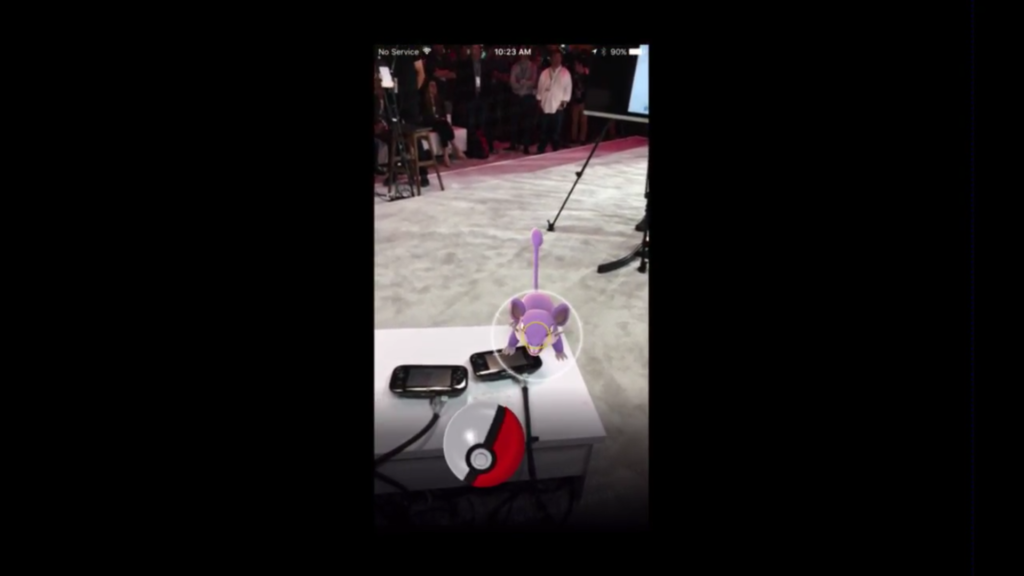On the second morning of the Electronic Entertainment Expo (E3), Nintendo’s Treehouse livestream gathered together key developers involved with Pokémon GO—an upcoming augmented reality mobile game that lets players explore real world locations to find, battle and capture Pokémon. The panel of speakers included Tsunekazu Ishihara, president and CEO of The Pokémon Company; Junichi Masuda, composer, designer, producer and programmer at Game Freak; Tatsuo Nomura, Niantic’s senior product manager; and Shigeru Miyamoto from Nintendo.
Four companies partnered together to make Pokémon GO a reality, and the game is currently undergoing real world field testing in Japan, US, New Zealand and Australia. Ishihara stated that he was very excited about the enthusiastic support for the game, evidenced by how many people signed up for field testing. Not bad for a game that got its start in 2013 as an April Fools’ Day joke done in collaboration with Google, called The Pokémon Challenge.
Nomura was one of the key people behind the April Fools’ Day project. He was a part of the Google Maps team in 2013, and now he’s at Niantic working on the real thing. He met with Ishihara and Niantic’s CEO John Hanke after The Pokémon Challenge was shown, and they all agreed that this was a great opportunity to bring Pokémon into the real world using the augmented reality technology used in games such as Ingress. Nomura went on to state that, with the current field testing, there are currently tens of thousands of players trying the game now, averaging about “30 pokéball throws per second.”
The game uses real world maps and location data on your phone to catch Pokémon. Players will have to explore the world and go to key locations to find specific kinds of Pokémon. For example, water Pokémon are found by the shore or bodies of water, while grass Pokémon are hidden among tall grass. Google mapping technology is being used to spread the Pokémon out, so players will have to explore past their local neighborhoods to find them all.
Ishihara noted that, because it’s the 20th anniversary of Pokémon, the testers will predominantly find the original types of Pokémon from the 1996 Red and Blue games. Featuring the original Pokémon has both a nostalgic appeal for longtime fans and sense of newness for more recent ones. More Pokémon will be added in the future.

Masuda did a live demonstration of capturing a Pokémon in front of an audience. Users will be able to control the spin and throw strength of the pokéball in an effort to pull off a successful capture. Additionally, throws must be timed according to a circular on-screen meter.
Of course, the developers don’t necessarily players staring at their phones while walking around. Nomura stated that Niantic wants players to take in the world around them, and not just stare at a screen. Helping to make the experience more convenient is a peripheral called Pokémon GO Plus, which Miyamoto wore a on his jacket lapel. It ties in with Pokémon GO and looks like a teardrop shaped pokéball pin that can also be placed on a wrist band. The device connects to smartphones via Bluetooth and essentially allows people to play Pokémon GO without having to look at their smartphones. The device will flash a green light and vibrate when there’s a Pokémon nearby. Capturing the Pokémon is a matter of pressing the button, which will flash a rainbow color if successful and red if not. Ishihara believes that the Pokémon GO Plus will become a must-have device when playing the game.
Then came the big question from fans: when will Pokémon GO finally come out of testing? Miyamoto surprised the everyone by responding, announcing that it will launch for both iOS and Android devices at the end of July, but did not give a specific day. However, the Pokémon GO Plus accessory—which will retail for $34.99—will not be ready at launch. Eventually, there may be connectivity between Pokémon GO and the upcoming Sun and Moon games for 3DS, and major events for fans to participate in.

